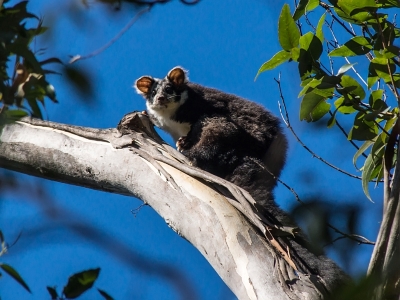Greater Glider
Petauroides Volans
The Greater Glider is the largest gliding possum with a head and body length of 350-450 mm, a tail length of 450-600 mm and weigh 900-1700 g. Their colour ranges from cream to dark grey/brown. They have a long furry tail and distinctive furry ears.

Greater Glider (image by David Cook)
Status
Vulnerable
Diet
The diet of a Greater Glider is almost exclusively eucalypt leaves, only eating the leaves of some eucalypt species high up in the canopy.
Habitat
They are primarily solitary animals requiring multiple large tree hollows for shelter, with home ranges of up to three to four hectares.
If they come down to the ground, they can be clumsy and have difficulty crossing open tree-less areas and exposing them to predators such as the Powerful Owl and foxes. They can be found in sites extending east from Woomargama National Park to the Upper Murray region.
They typically give birth to single young, with a life expectancy estimated at 15 years. Greater Gliders are sensitive to habitat alteration and fragmentation and rely on patches of old-growth habitat. They can glide up to 100 m with their tail acting as a rudder, steering the body.
Why is the Greater Gliders a threatened species?
- Loss and fragmentation of habitat.
- Climate change.
- Loss of hollow bearing trees.
- Increased frequency of bushfires.
- Barbed wire can entangle gliders and damage their gliding membranes.
How you can help the Greater Glider
- Retain hollow bearing trees.
- Let us know of any sightings.
- Plant native tree corridors to connect areas of remnant vegetation.
- Minimise barb wire especially on the top wire of fences adjoining forested areas.
- Install nest boxes PDF, 1482.87 KB in areas where hollow bearing trees are declining.
Projects to protect the Greater Glider
Riverina Local Land Services is undertaking a project to learn more about this species in the Batlow area. We will be working with ecologists to undertake preliminary surveys as well as providing funding for habitat enhancement activities.
We are interested to hear from landholders that:
- Have knowledge of any sightings of the Greater Glider in the local area
- Have areas of native vegetation including large unburnt old trees with large tree hollows
- Are interested in undertaking activities to improve habitat for the Greater Glider.
Questions?
Contact Cherie White – Senior Land Services Officer on 0427 407 126 or cherie.white@lls.nsw.gov.au
Who is involved?
This project has been assisted by the NSW Government through its Environmental Trust.